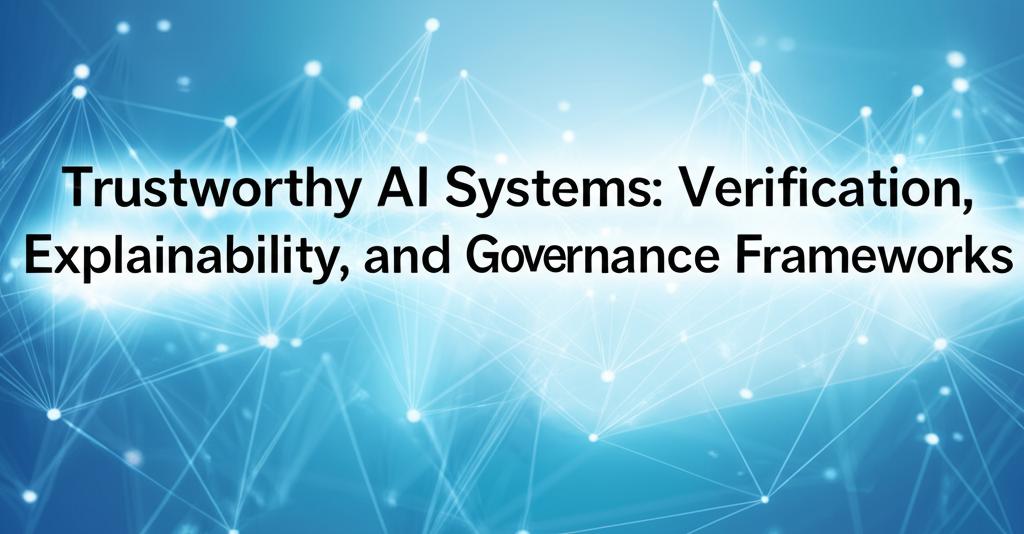Building artificial intelligence systems that people can rely on isn't automatic; it requires deliberate effort focused on several key areas. As AI becomes more integrated into critical aspects of business and daily life in 2025, ensuring these systems are trustworthy is paramount. This involves robust verification processes, clear explainability, and comprehensive governance frameworks.
Verification and Validation: Ensuring AI ReliabilityAt its core, AI verification and validation (V&V) is about confirming that an AI system performs reliably and accurately, especially in situations where errors could have significant consequences, such as healthcare or autonomous systems (Result 3, 24). It involves rigorous testing to ensure the system functions as intended and generalizes well to new, unseen data (Result 3, 7).
Key V&V techniques currently employed include:
- Functional Testing: Evaluating if the AI system's features work according to specifications (Result 3).
- Cross-Validation: Splitting datasets into subsets to train and test the model multiple times, assessing its ability to generalize and minimize overfitting. Techniques like K-Fold and Leave-One-Out Cross-Validation (LOOCV) are common (Result 3, 7, 24).
- Holdout Validation: Reserving a specific portion of data exclusively for testing the final model's performance (Result 7).
- A/B Testing: Comparing different versions of an AI model to see which performs better based on predefined metrics (Result 3).
- Ethics and Bias Testing: Specifically designing tests to identify and mitigate harmful biases in data and AI decisions to ensure fairness (Result 3).
- Model Drift Monitoring: Continuously tracking model performance and input data distributions once deployed to detect degradation or changes that necessitate retraining (Result 24).
- Data Validation: Employing automated methods like rule-based validation or machine learning techniques to ensure the quality, accuracy, and integrity of the data feeding the AI models (Result 22).
Effective V&V requires clear validation criteria aligned with goals, the use of diverse and representative test data, documenting processes for transparency, and continuous monitoring throughout the AI lifecycle (Result 7, 9, 24).
Explainable AI (XAI): Understanding the "Why"Many advanced AI models, particularly deep learning systems, operate as "black boxes," making it difficult to understand their reasoning (Result 18, 20). Explainable AI (XAI) encompasses methods and techniques designed to make these processes transparent and understandable to humans (Result 18, 20). This is crucial not just for debugging and improvement by developers, but also for building user trust, ensuring regulatory compliance, and allowing stakeholders to assess fairness and challenge decisions (Result 4, 5, 20).
Common XAI approaches include:
- Feature Importance: Identifying which input features most significantly influence a model's output (Result 5).
- Model-Agnostic Methods: Techniques like LIME (Local Interpretable Model-agnostic Explanations) or Saliency Maps that can provide explanations for various types of models (Result 5).
- Model-Specific Methods: Explanations tailored to specific model types, such as interpreting decision trees or rule-based systems (Result 5, 17).
- Counterfactual Explanations: Showing what minimal changes to the input would lead to a different outcome (Result 5).
- Visualization Techniques: Using graphs, heatmaps, or interactive interfaces to present AI decision-making processes intuitively (Result 5).
Integrating XAI from the design phase, rather than treating it as an afterthought, is a strategic enabler for AI adoption and success (Result 4). While challenges like the trade-off between model performance and explainability exist, the demand for transparency is driving innovation in XAI techniques (Result 5).
Governance Frameworks: Setting the Rules for Responsible AIAI governance provides the overarching structure—policies, standards, roles, and processes—to ensure AI systems are developed and deployed ethically, responsibly, and in compliance with laws and societal values (Result 16, 8). Strong governance is fundamental to managing AI risks, such as bias, privacy violations, and security vulnerabilities, and is essential for building and maintaining trust (Result 10, 16, 19).
Key elements of AI governance include:
- Risk Management Frameworks: Systematically identifying, assessing, and mitigating risks throughout the AI lifecycle. The NIST AI Risk Management Framework (RMF) is a widely referenced guide covering governance, mapping, measuring, and managing risks (Result 16, 19).
- Policies and Standards: Establishing clear internal rules for AI development, data handling, ethical considerations, human oversight, and compliance (Result 2, 16).
- Accountability and Oversight: Defining clear roles and responsibilities for AI development, deployment, and monitoring, including mechanisms for audits and human intervention (Result 2, 15).
- Data Governance: Implementing robust processes for managing the data used in AI, ensuring quality, integrity, privacy, and security, and mitigating bias (Result 9, 15, 16).
- Regulatory Compliance: Staying abreast of and adhering to evolving AI regulations. The EU AI Act is a landmark example, setting risk-based requirements, banning certain high-risk applications (effective Feb 2025), and establishing rules for general-purpose AI models (effective Aug 2025) (Result 1, 6, 8, 13). Other jurisdictions, including US states like California, are also implementing AI-specific rules (Result 6).
- Transparency and Documentation: Maintaining detailed records of AI system design, data sources, training methods, performance, and decision-making processes (Result 1, 9, 10).
As of May 2025, the AI governance landscape is rapidly evolving, demanding that organizations adopt agile yet comprehensive frameworks to navigate compliance and foster responsible innovation (Result 6, 8).
ConclusionAchieving trustworthy AI requires a holistic approach that integrates rigorous verification, meaningful explainability, and robust governance. These pillars are interconnected and indispensable. Verification builds confidence in AI performance, explainability fosters understanding and trust in AI decisions, and governance provides the ethical and regulatory guardrails. By prioritizing these areas, organizations can harness the transformative power of AI responsibly, ensuring systems are not only effective but also safe, fair, and aligned with human values, ultimately leading to greater adoption and societal benefit (Result 4, 9, 11, 15).

